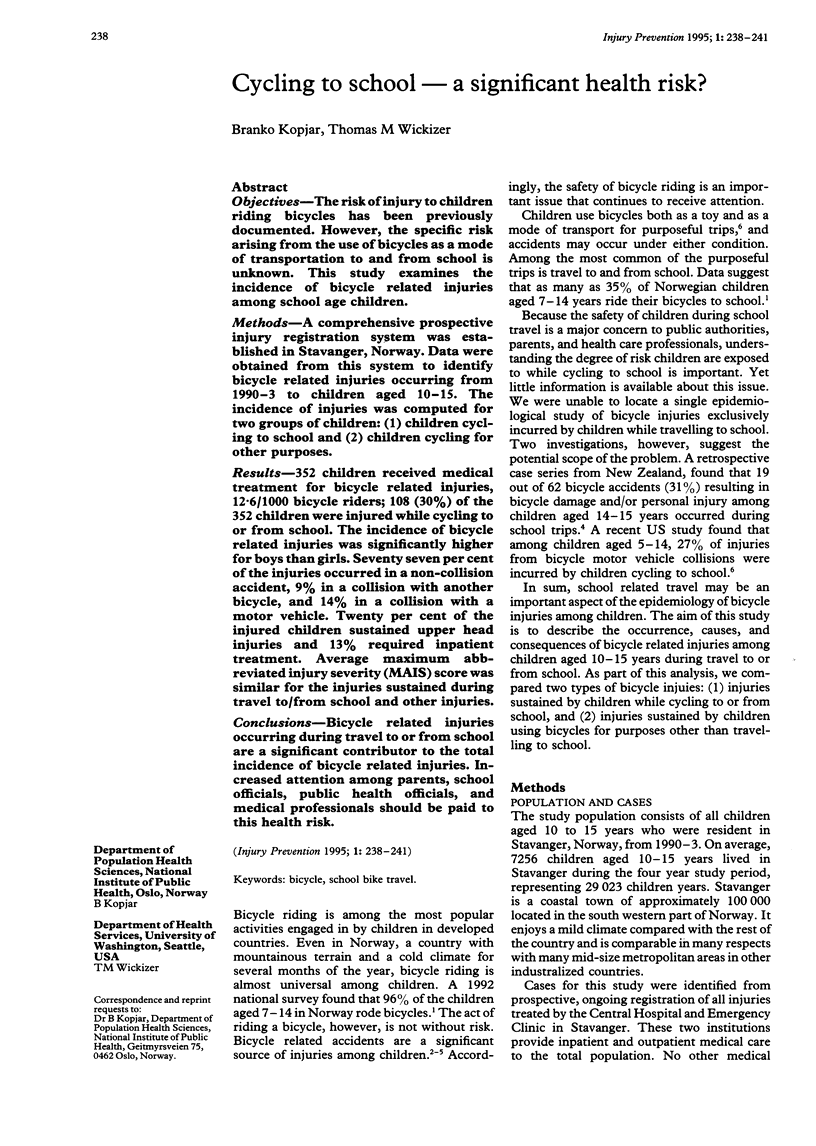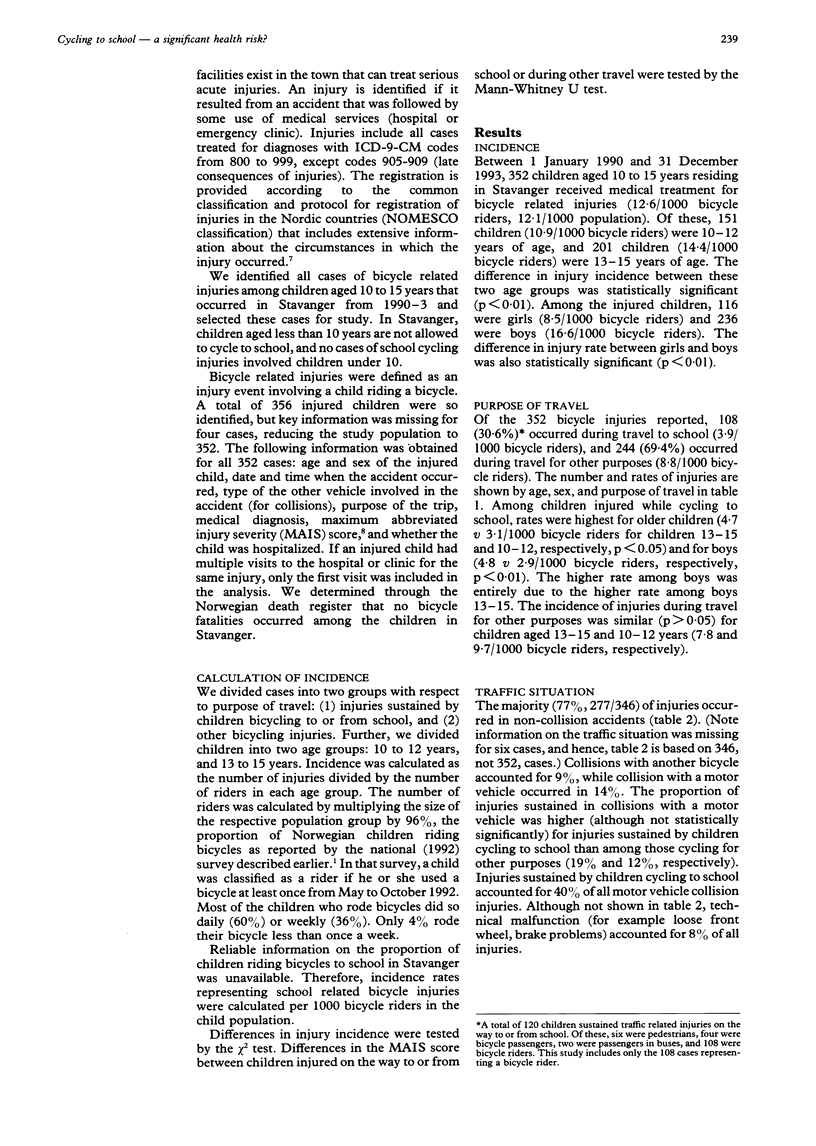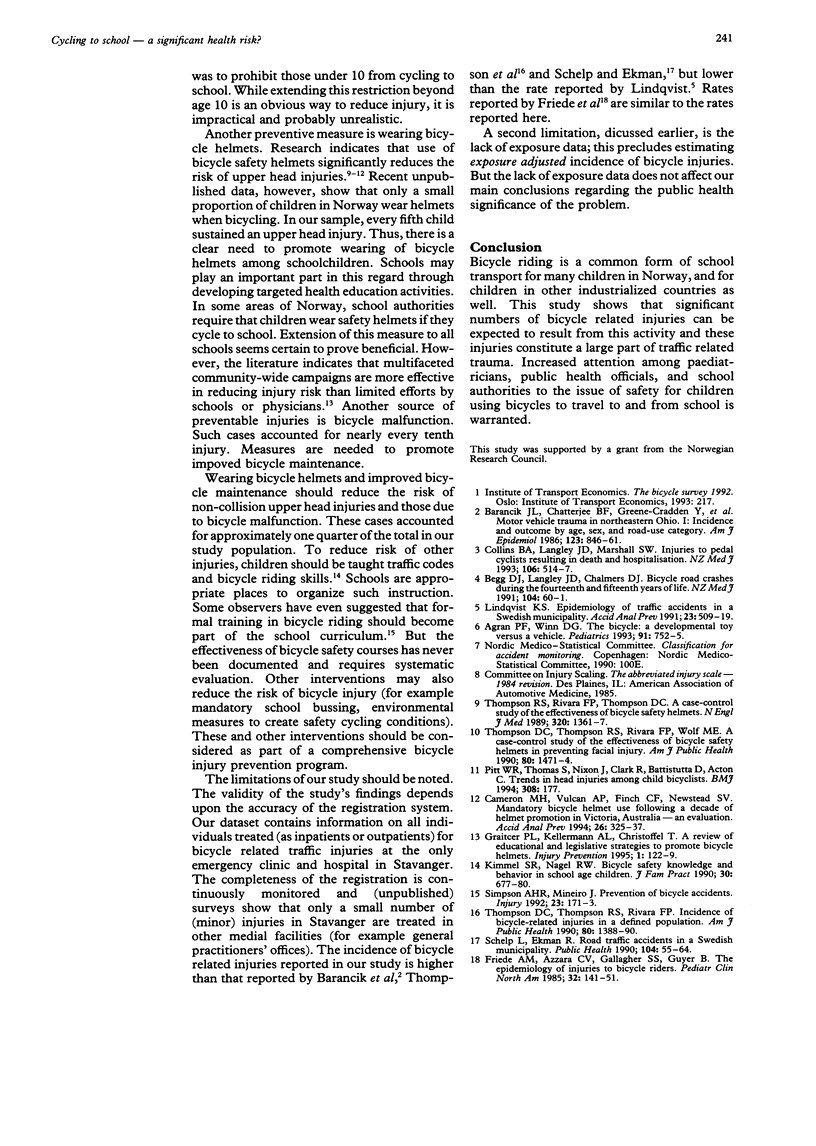Abstract
OBJECTIVES: The risk of injury to children riding bicycles has been previously documented. However, the specific risk arising from the use of bicycles as a mode of transportation to and from school is unknown. This study examines the incidence of bicycle related injuries among school age children. METHODS: A comprehensive prospective injury registration system was established in Stavanger, Norway. Data were obtained from this system to identify bicycle related injuries occurring from 1990-3 to children aged 10-15. The incidence of injuries was computed for two groups of children: (1) children cycling to school and (2) children cycling for other purposes. RESULTS: 352 children received medical treatment for bicycle related injuries, 12.6/1000 bicycle riders; 108 (30%) of the 352 children were injured while cycling to or from school. The incidence of bicycle related injuries was significantly higher for boys than girls. Seventy seven per cent of the injuries occurred in a non-collision accident, 9% in a collision with another bicycle, and 14% in a collision with a motor vehicle. Twenty per cent of the injured children sustained upper head injuries and 13% required inpatient treatment. Average maximum abbreviated injury severity (MAIS) score was similar for the injuries sustained during travel to/from school and other injuries. CONCLUSIONS: Bicycle related injuries occurring during travel to or from school are a significant contributor to the total incidence of bicycle related injuries. Increased attention among parents, school officials, public health officials, and medical professionals should be paid to this health risk.
Full text
PDF



Selected References
These references are in PubMed. This may not be the complete list of references from this article.
- Agran P. F., Winn D. G. The bicycle: a developmental toy versus a vehicle. Pediatrics. 1993 Apr;91(4):752–755. [PubMed] [Google Scholar]
- Barancik J. I., Chatterjee B. F., Greene-Cradden Y. C., Michenzi E. M., Kramer C. F., Thode H. C., Jr, Fife D. Motor vehicle trauma in northeastern Ohio. I: Incidence and outcome by age, sex, and road-use category. Am J Epidemiol. 1986 May;123(5):846–861. doi: 10.1093/oxfordjournals.aje.a114314. [DOI] [PubMed] [Google Scholar]
- Begg D. J., Langley J. D., Chalmers D. J. Bicycle road crashes during the fourteenth and fifteenth years of life. N Z Med J. 1991 Feb 27;104(906):60–61. [PubMed] [Google Scholar]
- Cameron M. H., Vulcan A. P., Finch C. F., Newstead S. V. Mandatory bicycle helmet use following a decade of helmet promotion in Victoria, Australia--an evaluation. Accid Anal Prev. 1994 Jun;26(3):325–337. doi: 10.1016/0001-4575(94)90006-x. [DOI] [PubMed] [Google Scholar]
- Collins B. A., Langley J. D., Marshall S. W. Injuries to pedal cyclists resulting in death and hospitalisation. N Z Med J. 1993 Dec 8;106(969):514–516. [PubMed] [Google Scholar]
- Friede A. M., Azzara C. V., Gallagher S. S., Guyer B. The epidemiology of injuries to bicycle riders. Pediatr Clin North Am. 1985 Feb;32(1):141–151. doi: 10.1016/s0031-3955(16)34762-9. [DOI] [PubMed] [Google Scholar]
- Graitcer P. L., Kellermann A. L., Christoffel T. A review of educational and legislative strategies to promote bicycle helmets. Inj Prev. 1995 Jun;1(2):122–129. doi: 10.1136/ip.1.2.122. [DOI] [PMC free article] [PubMed] [Google Scholar]
- Kimmel S. R., Nagel R. W. Bicycle safety knowledge and behavior in school age children. J Fam Pract. 1990 Jun;30(6):677–680. [PubMed] [Google Scholar]
- Lindqvist K. S. Epidemiology of traffic accidents in a Swedish municipality. Accid Anal Prev. 1991 Dec;23(6):509–519. doi: 10.1016/0001-4575(91)90016-x. [DOI] [PubMed] [Google Scholar]
- Pitt W. R., Thomas S., Nixon J., Clark R., Battistutta D., Acton C. Trends in head injuries among child bicyclists. BMJ. 1994 Jan 15;308(6922):177–177. doi: 10.1136/bmj.308.6922.177. [DOI] [PMC free article] [PubMed] [Google Scholar]
- Schelp L., Ekman R. Road traffic accidents in a Swedish municipality. Public Health. 1990 Jan;104(1):55–64. doi: 10.1016/s0033-3506(05)80346-4. [DOI] [PubMed] [Google Scholar]
- Simpson A. H., Mineiro J. Prevention of bicycle accidents. Injury. 1992;23(3):171–173. doi: 10.1016/s0020-1383(05)80038-5. [DOI] [PubMed] [Google Scholar]
- Thompson D. C., Thompson R. S., Rivara F. P. Incidence of bicycle-related injuries in a defined population. Am J Public Health. 1990 Nov;80(11):1388–1390. doi: 10.2105/ajph.80.11.1388. [DOI] [PMC free article] [PubMed] [Google Scholar]
- Thompson D. C., Thompson R. S., Rivara F. P., Wolf M. E. A case-control study of the effectiveness of bicycle safety helmets in preventing facial injury. Am J Public Health. 1990 Dec;80(12):1471–1474. doi: 10.2105/ajph.80.12.1471. [DOI] [PMC free article] [PubMed] [Google Scholar]
- Thompson R. S., Rivara F. P., Thompson D. C. A case-control study of the effectiveness of bicycle safety helmets. N Engl J Med. 1989 May 25;320(21):1361–1367. doi: 10.1056/NEJM198905253202101. [DOI] [PubMed] [Google Scholar]


